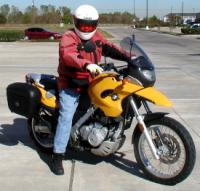BMW Motorcycles
 BMW, Bavarian Motor Works, formed in Germany in 1916 to build military aircraft engines for the war effort. The familiar BMW blue and white roundel is popularly believed to represent a stylized propeller spinning against a blue sky. Others say it was inspired by the blue and white checkered Bavarian flag. BMW is one of the few motorcycle companies that expanded into the automobile business, Honda and Suzuki being two others. BMW's motorcycle division is BMW Motorrad.
BMW, Bavarian Motor Works, formed in Germany in 1916 to build military aircraft engines for the war effort. The familiar BMW blue and white roundel is popularly believed to represent a stylized propeller spinning against a blue sky. Others say it was inspired by the blue and white checkered Bavarian flag. BMW is one of the few motorcycle companies that expanded into the automobile business, Honda and Suzuki being two others. BMW's motorcycle division is BMW Motorrad.
At the conclusion of the Great War, The Treaty of Versailles spelled out the terms of Imperial Germany's defeat. Among other things, the victors changed the name to the Weimar Republic, they changed the flag from black, red and white to black, red and yellow and they prohibited production of war materiel.
This meant that BMW could no longer manufacture aircraft engines so they turned to making engines for other motorcycle manufacturers. In 1923, BMW introduced their own complete motorcycle, a shaft-drive horizontally-opposed twin not unlike the design produced to this day.
Between hostilities, BMW applied their experience with supercharging aircraft engines to supercharging their racing motorcycles and dominated the sport until supercharging was prohibited. BMW also did well in sidecar races winning the World Championship every year from 1954 through 1966 and many other times thereafter.
In 1935, BMW introduced the first oil-damped telescopic front forks, a significant contribution to the industry and to riders everywhere. 1938 saw the addition of telescopic rear suspension after sorting out the shaft drive coupling.
At the conclusion of WWII, BMW's Spandau facility in East Germany fell into the hands of the Russians. Russia continues to make a 1930s BMW knockoff known as the Ural, which is now imported into the United States. Sidecar models are also available.
In 1983, BMW launched the water-cooled K series with an inline-four cylinder engine lying on its side. Affectionately nicknamed the Brick, a three-cylinder model came out in 1985. BMW believed that the K would replace the venerable flat-twin R series, but BMW enthusiasts were not so ready for change. At about the same time, adventure touring became the rage and the Paris-Dakar winning R80GS defined the sport, creating a new market and breathing new life into the company.
Though best known for their twins, between 1925 and 1967 BMW manufactured single-cylinder motorcycles of 250cc, 300cc, 400cc and 450cc. In 1993, BMW again began offering a single in the form of the F650 Funduro, which was followed in 2001 by the F650GS and Dakar dual-sport bikes and the F650CS street model.
In 2007, BMW added the G650 X-series. The X is pronounced cross and the series includes the Xcountry, Xmoto and Xchallenge. BMW Motorrad also began racing an F450GS enduro. The new vertical-twin F800GS and F800R fill the gap between the 650s and the big R1200GS.
 The author is proud to own a 2002 BMW F650GS in yummi Mandarin Yellow sporting Givi sidecases and a Touratech low fender.
The author is proud to own a 2002 BMW F650GS in yummi Mandarin Yellow sporting Givi sidecases and a Touratech low fender.
After this picture was taken, the author replaced the Givi windshield with a Parabellum windshield and BMW handguards and bar end weights. Purchased used with 4,000 miles on the odometer in May 2006, Mad Mac is looking forward to more adventures.
